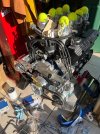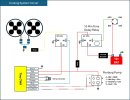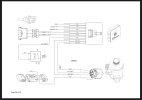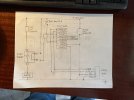Mid engine cars are just more complicated compared to front engine/rear drive or rear engine rear/drive. Even the OEMs have challenges with engine compartment heat, reduced lifespan of soft parts in the engine compartment, plumbing, cooling, wiring, a/c and tool access for routine maintenance.
If you are prepared to do the best you can with the information available (especially GT40s.com) AND prepared to potentially take it apart because of an unforeseen packaging issue or systems malfunctioning, you are on the way to building an exceptional car.
Regarding the ability to heat the cockpit, there's no shortage of hot water in a GT40 replica or original.
Most of the conventional wisdom about heater function in hand built cars comes from the likes of hot rods, restomods and sports cars based on front engine front radiator layouts. Not much help there, just pay attention the height of your header tank and bubble bleed lines.
In GT40 applications you have several options based on your chassis manufacture provisions and your choice of drivetrains for routing coolant pipes between the engine, radiator and heater.
Although "individual circumstances may vary", the simple mechanical waterpump with thermostat, bypass plumbing, adequate rad fans and proper fan controller combination should give no trouble cooling the engine or heating the cockpit. Although the accessory drive is more complex and space to the firewall almost non existent.
Back to the topic of this thread:
The use of a remote mounted electric water pump reduces accessory drive complexity and provides more space to the firewall. The electric water pump on/off/variable speed and radiator fan(s) on/off/speed have to be managed by the ECU or other controllers. A mechanical thermostat is redundant in this setup.
With proper control of the water pump and rad fans to engine will warm up quite quickly if the car is happy to idle for a few minutes. Then you have hot water available...
The tight packaging of the engine compartment, under dash area and plumbing routes will narrow your choices as to where to run the heater hoses. The direction of flow however is always the same: from the engine to the heater to the radiator inlet. It's preferable to mount the heater shutoff or variable flow valve outside the cockpit, reducing the number of really hot water leaks.
The system itself is not difficult, it's the packaging layout and leaving yourself access for future maintenance that's the challenge.
Cheers
Ian
If you are prepared to do the best you can with the information available (especially GT40s.com) AND prepared to potentially take it apart because of an unforeseen packaging issue or systems malfunctioning, you are on the way to building an exceptional car.
Regarding the ability to heat the cockpit, there's no shortage of hot water in a GT40 replica or original.
Most of the conventional wisdom about heater function in hand built cars comes from the likes of hot rods, restomods and sports cars based on front engine front radiator layouts. Not much help there, just pay attention the height of your header tank and bubble bleed lines.
In GT40 applications you have several options based on your chassis manufacture provisions and your choice of drivetrains for routing coolant pipes between the engine, radiator and heater.
Although "individual circumstances may vary", the simple mechanical waterpump with thermostat, bypass plumbing, adequate rad fans and proper fan controller combination should give no trouble cooling the engine or heating the cockpit. Although the accessory drive is more complex and space to the firewall almost non existent.
Back to the topic of this thread:
The use of a remote mounted electric water pump reduces accessory drive complexity and provides more space to the firewall. The electric water pump on/off/variable speed and radiator fan(s) on/off/speed have to be managed by the ECU or other controllers. A mechanical thermostat is redundant in this setup.
With proper control of the water pump and rad fans to engine will warm up quite quickly if the car is happy to idle for a few minutes. Then you have hot water available...
The tight packaging of the engine compartment, under dash area and plumbing routes will narrow your choices as to where to run the heater hoses. The direction of flow however is always the same: from the engine to the heater to the radiator inlet. It's preferable to mount the heater shutoff or variable flow valve outside the cockpit, reducing the number of really hot water leaks.
The system itself is not difficult, it's the packaging layout and leaving yourself access for future maintenance that's the challenge.
Cheers
Ian




